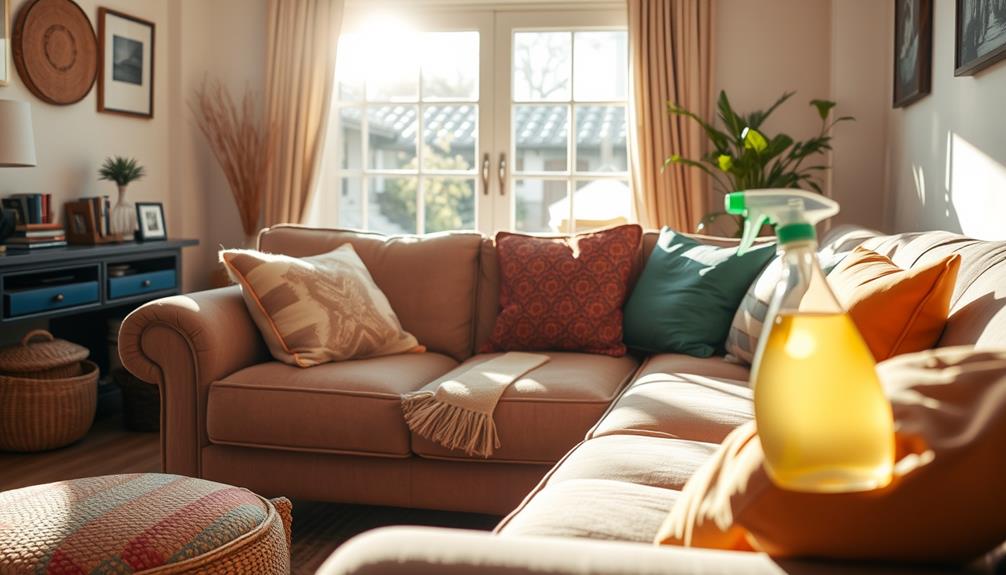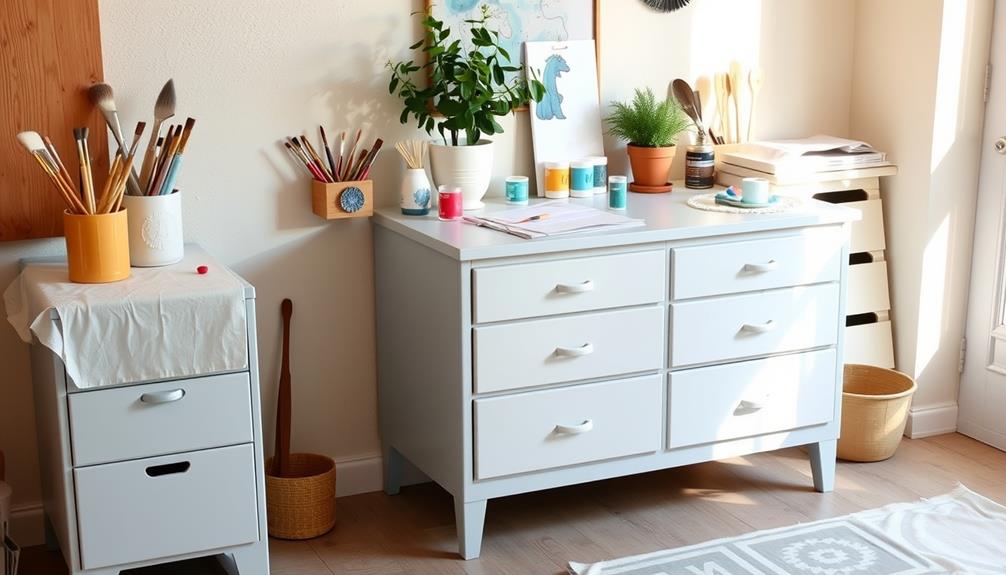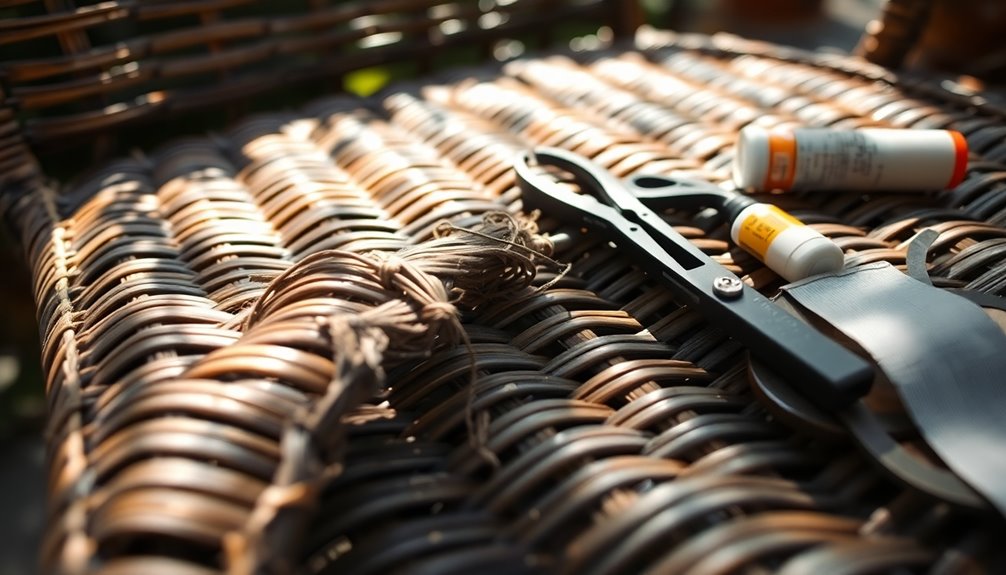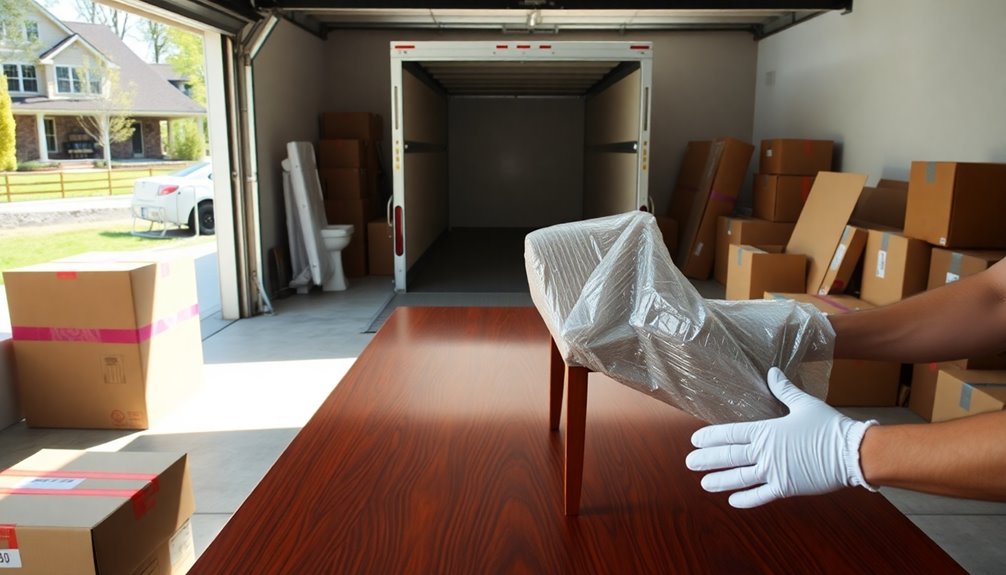To begin the process of cleaning your fabric sofa, make sure to thoroughly vacuum the surface to eliminate any dust and crumbs. It’s important to refer to the care tag on the sofa for specific cleaning codes that will determine the best cleaning method to use. When dealing with stains, promptly blot spills with a cloth and create a mixture of distilled water and dish soap for cleaning purposes. For a deeper clean, consider using a steam cleaner. Regularly fluff and rotate the cushions to ensure they maintain their shape. To eliminate odors, sprinkle baking soda on the sofa and vacuum it up after a few hours. By following these steps, your sofa will look great and last longer. For more tips on effective cleaning techniques, visit the link.
If you prefer to clean your fabric sofa in a natural way, you can also try using a solution of vinegar and water to spot clean stains. Another alternative is to create a paste using baking soda and water to address tough stains, allowing it to sit before wiping it off. To refresh the sofa in a natural manner, consider placing small sachets of dried lavender or cedar inside the cushions. These environmentally friendly cleaning methods are not only effective but also safe for your home.
Key Takeaways
- Always check the care tag for cleaning codes to determine the appropriate cleaning method for your fabric sofa.
- Vacuum your sofa weekly to remove dust, crumbs, and pet hair, promoting cleanliness and preventing buildup.
- For spills, immediately blot with an absorbent cloth and use a gentle cleaning solution like distilled water and dish soap.
- Deep clean your sofa once or twice a year using an upholstery cleaning machine or steam cleaner for best results.
- Test any cleaning solution on a hidden area first to avoid discoloration or damage to the fabric.
Cleaning Tools and Supplies
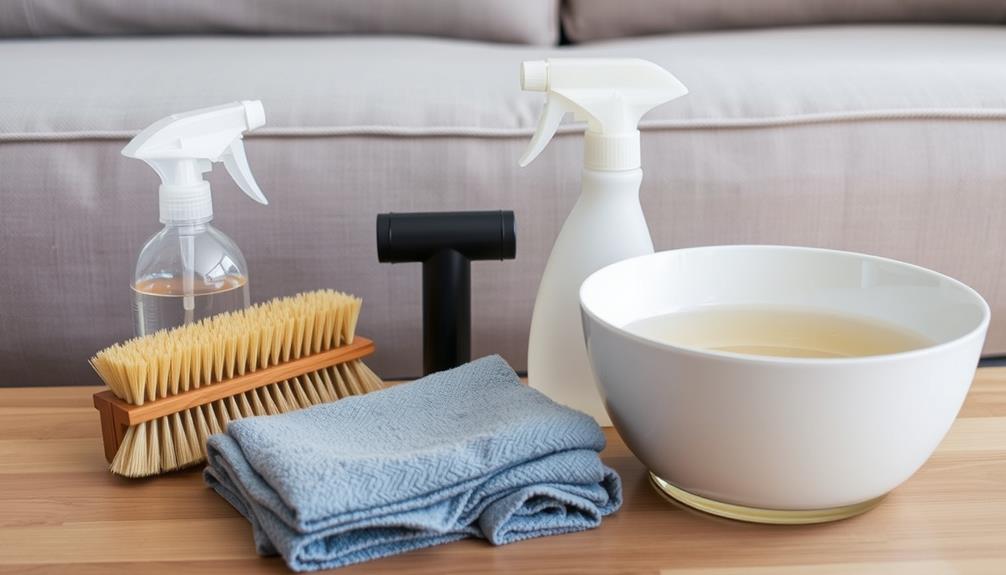
When it comes to keeping your fabric sofa looking its best, having the right cleaning tools and supplies is crucial. Start with a powerful vacuum, like a Dyson, to remove dust and crumbs regularly. This guarantees your sofa stays fresh and clean. Additionally, using a fabric brush or lint roller will help to remove any pet hair that may have accumulated. It is also important to establish and enforce a rule to keep dog off sofa to prevent any unwanted stains or odors. By incorporating these cleaning tools and practices into your routine, you can ensure that your fabric sofa remains in great condition for years to come.
For deeper stains, an upholstery cleaning machine, such as the Bissell Little Green, is invaluable. It tackles tough spots that a vacuum can't handle. Additionally, regular maintenance and cleaning can greatly enhance the longevity of your furniture, similar to how fuel injection cleaning improves vehicle performance.
A lint brush is also a handy tool for quick touch-ups, effortlessly removing hair and dust from the fabric surface. Don't forget about a fabric shaver, which can eliminate pilling and fuzz, enhancing your sofa's appearance.
To protect your investment, apply Scotchgard to repel stains and liquids. This protective spray acts as a barrier, making clean-ups easier and prolonging the life of your fabric sofa.
Pair these tools with an appropriate cleaning solution designed for upholstery to tackle any spills or stains effectively. With the right arsenal of cleaning tools and supplies, maintaining your fabric sofa becomes a breeze, allowing you to enjoy its comfort and style for years to come.
Manufacturer's Instructions
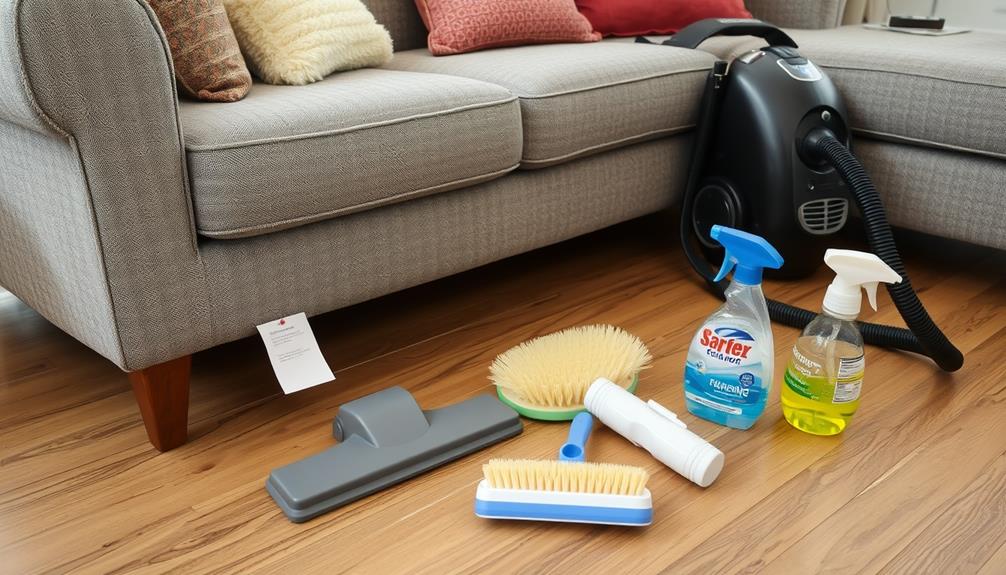
Before you start cleaning your fabric sofa, it's important to check the manufacturer's cleaning instructions on the care tag. This tag contains essential information about the fabric type and specific cleaning codes (W, S, WS, X) that indicate which cleaning methods and products are safe to use.
By ignoring these instructions, you risk voiding warranties and causing irreversible damage to your sofa. Understanding the financial implications of maintaining your furniture can also help prioritize your spending, as investing in quality care can extend the life of your sofa, leading to long-term savings and less frequent replacements.
Financial mistakes to avoid can include neglecting proper care for your valuable items.
The manufacturer's instructions often provide detailed guidelines for both spot cleaning and deep cleaning. For instance, some fabrics may require water-based cleaning products, while others may only be safe with solvent-based cleaners.
It's important to use the recommended cleaning products tailored to your fabric type to maintain the sofa's appearance and longevity.
Before diving into any cleaning, take a moment to familiarize yourself with these instructions. They'll help you avoid costly mistakes and guarantee your fabric sofa stays in excellent condition.
Ultimately, following the manufacturer's instructions is key to preserving the overall quality of your furniture. So, make that care tag your first stop before you grab any cleaning supplies!
Understanding Cleaning Tags
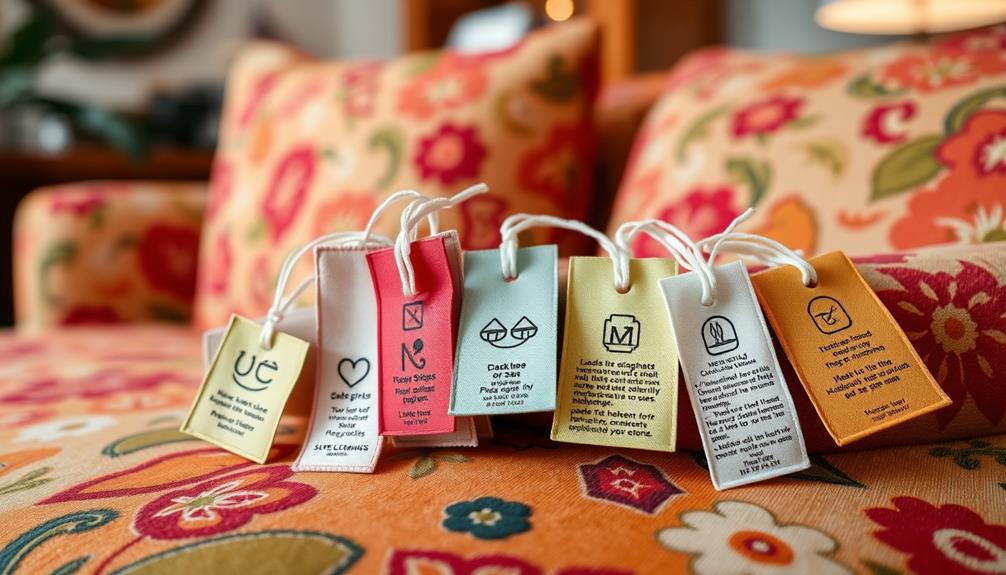
When it comes to cleaning your fabric sofa, understanding the cleaning codes on the tag is essential.
These codes tell you what cleaning methods you can safely use, ensuring you don't accidentally damage the fabric.
For instance, using a vacuum with superior dust and allergen elimination can help maintain cleanliness without causing harm.
Familiarizing yourself with these codes will help you maintain your sofa's appearance and longevity.
Importance of Cleaning Codes
Understanding cleaning codes on fabric sofas is important for maintaining their appearance and longevity, as these codes provide essential information about the appropriate cleaning methods. Each cleaning tag displays specific codes: "W" means you can use water-based cleaners, "S" indicates solvent-based cleaners only, "WS" allows for both, and "X" signifies that vacuuming is the only method permitted.
Using a specialized vacuum designed for fabric upholstery can enhance your cleaning routine, guaranteeing that dirt and allergens are effectively removed, leading to a healthier living environment. Many best vacuums for pet hair are equipped with features that help tackle stubborn stains and pet hair, making them ideal for maintaining your sofa.
Following these cleaning codes is critical to prevent damage to your fabric upholstery. Using the wrong cleaning method can void warranties or lead to costly repairs. By checking the manufacturer's instructions, you verify compliance with their guidelines for best results.
Understanding these codes helps you identify the best approach for different upholstery types, allowing for effective stain removal while preserving the fabric's appearance. For instance, if your sofa has a "W" code, you can confidently use a water-based cleaner to clean your couch. However, if it's marked with "S," you'll need to stick to solvent-based cleaners.
Ultimately, adhering to these cleaning codes not only protects your investment but also keeps your sofa looking fresh and inviting for years to come.
Common Fabric Cleaning Codes
Knowing the common fabric cleaning codes can make a significant difference in how you care for your sofa. These cleaning codes, typically found on care tags, guide you in choosing the right cleaning method based on your upholstery's fabric type.
For instance, if you see a "W," it means you can safely use water-based cleaners. Conversely, an "S" indicates that only solvent-based cleaners are suitable. If your care tag has a "WS," you can opt for either water or solvent cleaners.
Additionally, it's important to take into account the energy-efficient appliances that may help maintain a comfortable home environment while cleaning.
However, if the code is "X," it's vital to remember that only vacuuming or light brushing is allowed—no liquid cleaning methods. Using the wrong cleaner can lead to irreversible damage and may even void your manufacturer's warranty.
Always check those care tags before attempting any cleaning. Following these guidelines not only guarantees your fabric looks its best but also extends the life of your sofa.
Regular Maintenance Tips
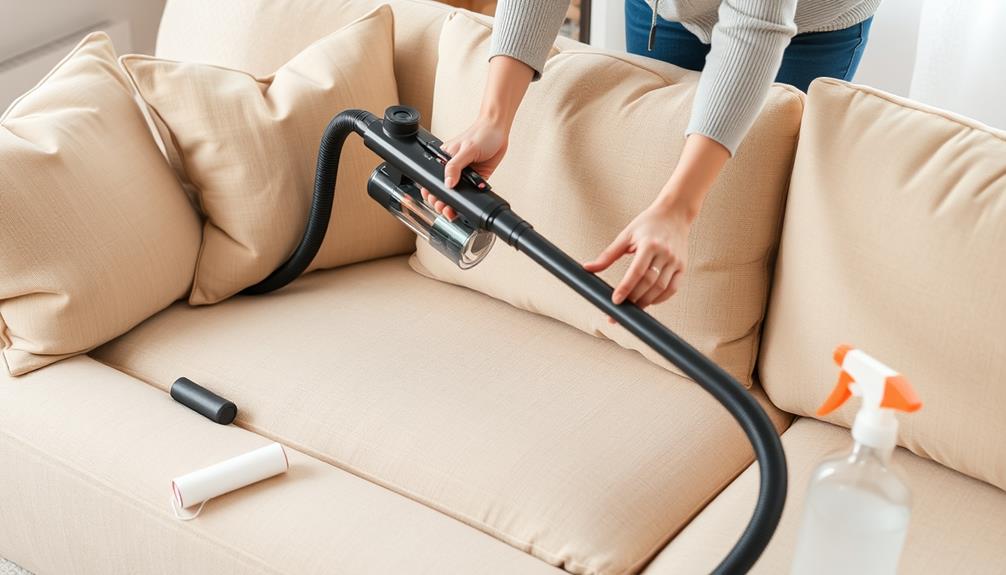
To keep your fabric sofa looking its best, regular maintenance is key.
Start by vacuuming weekly to remove dust and pet hair, and don't forget to fluff and rotate the cushions to maintain their shape.
For ideal air quality in your living space, consider incorporating an air purifier for effective allergen removal.
When spills happen, act fast and blot them up immediately to prevent stains from setting in.
Frequent Vacuuming Importance
Frequent vacuuming is vital for keeping your fabric sofa looking fresh and clean. Regularly vacuuming helps remove dust, crumbs, and hair, which is fundamental for maintaining the sofa's appearance and hygiene.
If you have pets or experience high foot traffic, aim to vacuum at least once a week, or even more often to prevent dirt buildup. Additionally, consider the potential allergens that can accumulate in your upholstery, which may affect your indoor air quality; consequently, regular maintenance is important for a healthier home environment reducing allergens in the home.
Here are some tips to guarantee effective vacuuming:
- Use an Upholstery Attachment: This helps reach crevices and under cushions where debris tends to accumulate.
- Vacuum Removable Cushions: Lifting and vacuuming both sides of removable cushions can greatly improve cleanliness and extend the fabric's lifespan.
- Focus on High-Traffic Areas: Pay special attention to areas that see the most use to maintain appearance.
- Reduce Allergens: Regular vacuuming helps reduce allergens in the home, contributing to better indoor air quality and a healthier living environment.
Cushion Care Practices
Caring for your cushions is essential to keeping your fabric sofa in top shape. Start by regularly fluffing and rotating cushions to maintain their shape and promote even wear. This practice helps avoid a lumpy appearance over time.
Incorporating essential oils like peppermint oil can also help refresh your cushions, as its invigorating scent can elevate the overall ambiance of your living space. If your sofa features removable cushion covers, vacuum both sides along with the underlying sofa area to eliminate dust, crumbs, and debris that can hide in crevices.
When it comes to accidental spills, spot clean stains immediately with a suitable cleaning solution based on the fabric type. Quick action can help you remove stains before they become permanent.
Don't forget to periodically shake out and air out cushions to refresh them and reduce lingering odors. This simple step enhances the overall comfort of your sofa.
Lastly, always follow the manufacturers' care instructions found on cleaning tags. These guidelines provide specific recommendations on cleaning methods and products to guarantee you avoid any fabric damage.
Immediate Spill Response
Accidents happen, and knowing how to respond quickly can save your fabric sofa from lasting damage.
An effective immediate spill response is essential in preventing stains from setting. For pet owners, it's also helpful to understand proper pet care to avoid additional messes.
Here's what you should do:
- Blot the Spill: Use a clean, absorbent cloth to gently blot the spill. Avoid scrubbing, as this can push the stain deeper into the fabric.
- Prepare a Cleaning Solution: For liquid spills, mix distilled water with a few drops of dish soap. This will help break down the stain.
- Test the Solution: Before applying any cleaning solution, always test it on a hidden area of the sofa. This guarantees it won't damage or discolor the fabric.
- Continue Blotting: Dampen your cloth with the cleaning solution and blot the affected area until the stain lifts. Be patient; it may take a few attempts.
Regularly vacuuming your sofa also helps prevent debris buildup, making it easier to clean spills when they occur.
With these steps, you can keep your fabric sofa looking fresh and clean!
Deep Cleaning Techniques
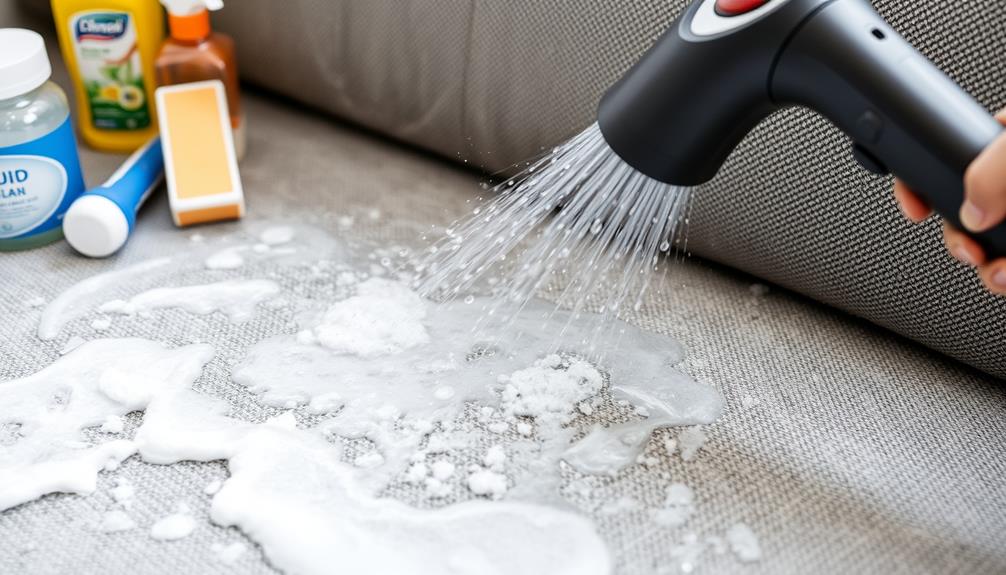
When it comes to deep cleaning your fabric sofa, using the right techniques can make all the difference. Start by utilizing an upholstery steam cleaner, which can effectively lift embedded dirt and stubborn stains. The Bissell Little Green Machine is a popular choice for its portability and powerful stain-removing capabilities.
To guarantee ideal results, consider using a cleaning solution that's safe for fabric and doesn't contain harsh chemicals, as well-draining soil is important for healthy plants—similarly, the right products can help maintain the integrity of your sofa. Before applying any cleaning solution, make sure to perform a spot test on a hidden area of the fabric to avoid potential damage.
If your sofa has removable covers, take advantage of this feature. You can typically wash or dry clean them according to the manufacturer's instructions, guaranteeing a thorough clean for high-traffic areas.
Regular deep cleaning is essential, so aim to do this once or twice a year to maintain your sofa's appearance and hygiene while prolonging its lifespan.
Incorporating these deep cleaning techniques won't only refresh your fabric sofa but also enhance its durability. Make sure to follow the right steps and use the appropriate tools to achieve the best results, keeping your sofa looking and feeling its best for years to come.
Stain Removal Methods
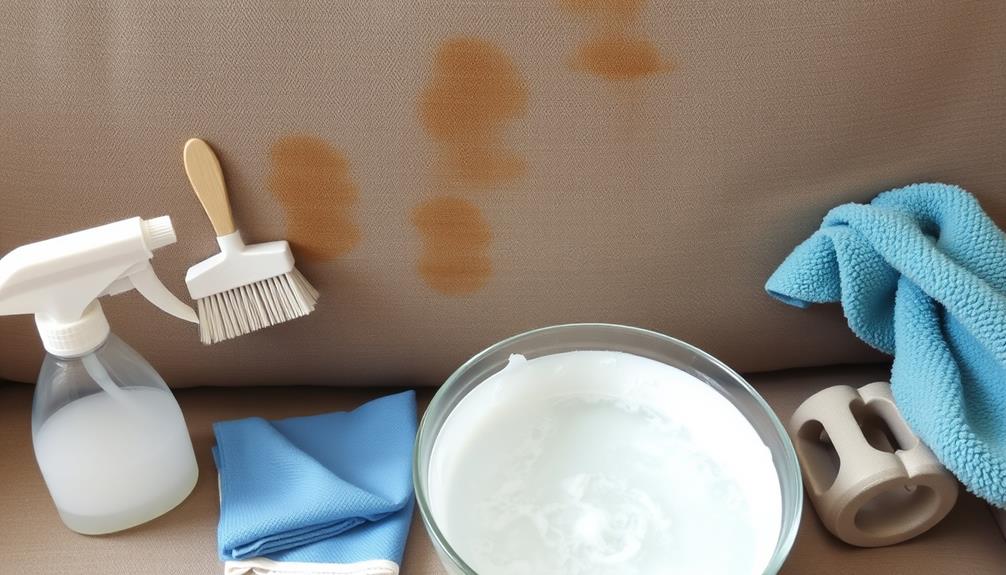
Dealing with stains on your fabric sofa can feel intimidating, but knowing the right methods can make the process much easier. Here are some effective stain removal methods to help you clean a fabric sofa:
- Act Quickly: Blot spills immediately with an absorbent cloth. Avoid rubbing, as this can push the stain deeper into the fabric.
- Vinegar Cleaning Solution: Mix warm water, vinegar, and dish soap to create a gentle cleaning solution. Use a microfiber cloth to apply it to the stained area, and remember to perform a spot test on an inconspicuous area first to avoid discoloration.
- Baking Soda Paste: For greasy stains, mix baking soda with water to form a paste. Apply it to the stain and let it sit for 15-20 minutes before wiping it clean with a damp cloth.
- Upholstery Cleaner: For larger or tougher stains, consider using a portable upholstery cleaner like the Bissell Little Green Machine. It's effective for deep cleaning fabric surfaces, including pet stains.
Steam Cleaning Procedures
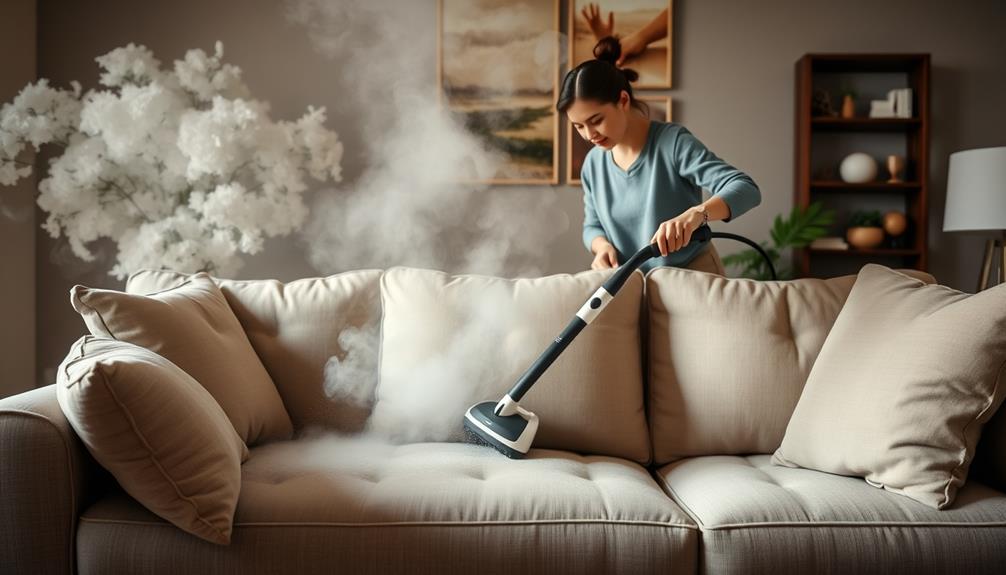
Steam cleaning is one of the most effective ways to refresh and sanitize your fabric sofa. Before you start, check the cleaning code on your sofa—look for a "W" or "WS," which means it's suitable for water-based cleaning methods. Begin by vacuuming the sofa thoroughly to remove loose dirt and debris, guaranteeing better results.
Next, fill your steam cleaner's water tank with distilled water. This helps prevent mineral deposits from damaging the fabric. Follow the manufacturer's instructions carefully, applying steam evenly across the sofa. Avoid over-saturating any areas, as this could lead to damage.
After steam cleaning, it's vital to let your sofa air dry completely to prevent mildew. You might want to use a fan to speed up the drying process. Here's a quick reference table to guide you through the steam cleaning procedures:
| Step | Action |
|---|---|
| 1. Check Code | Look for "W" or "WS" |
| 2. Vacuum | Remove loose dirt |
| 3. Fill Cleaner | Use distilled water |
| 4. Apply Steam | Follow manufacturer's instructions |
| 5. Air Dry | Guarantee complete drying |
Odor Removal Strategies
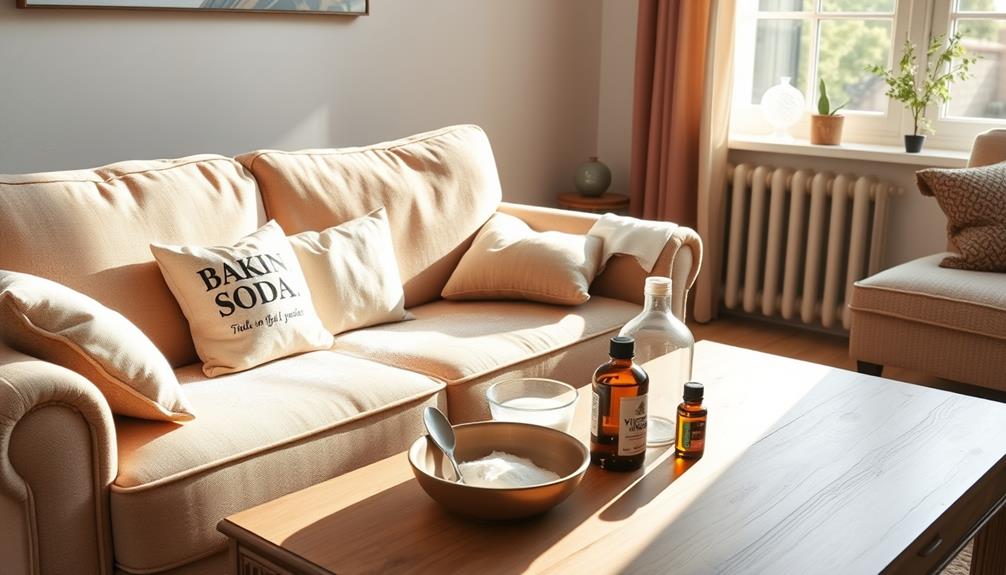
Over time, fabric sofas can develop unpleasant odors that may linger despite regular cleaning. To effectively tackle these smells, try the following odor removal strategies:
- Baking Soda: Sprinkle baking soda generously over your couch and let it sit for 20 minutes to 1 hour. This natural deodorizer absorbs odors, especially if you focus on heavily soiled areas. Vacuum it up afterward.
- Distilled White Vinegar Solution: For stubborn odors, mix equal parts distilled white vinegar and water in a spray bottle. Lightly mist the affected areas and let them air dry. This will help neutralize unpleasant smells.
- Regular Vacuuming: Make vacuuming a routine task. Focus on crevices and under cushions to prevent the buildup of dust and allergens, which can contribute to odors.
- Enzymatic Cleaner for Pet Odors: If you're dealing with persistent pet odors, consider using an enzymatic cleaner. These products break down organic materials effectively. Just be sure to follow the manufacturer's instructions for best results.
Implement these strategies to keep your fabric couch smelling fresh!
User Experiences and Best Fabrics
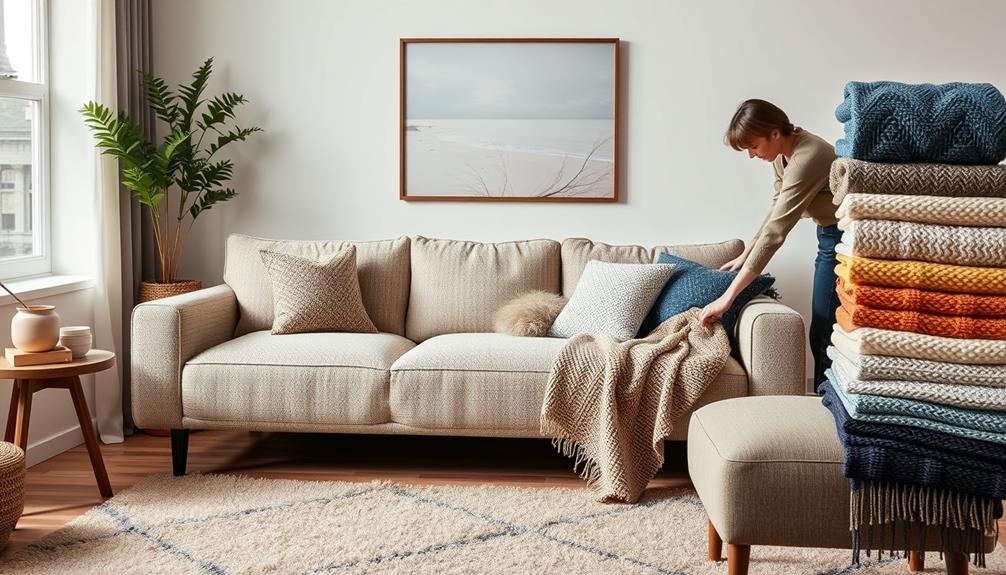
When choosing a fabric sofa, user experiences can guide you toward the best options for your lifestyle. Many users find that synthetic materials, like microfiber, are ideal for cleaning your sofa. They're resistant to stains and spills, making them perfect for homes with kids and pets.
If you choose lighter colors, such as white fabric, OxiClean often gets rave reviews for restoring brightness and tackling tough stains effectively.
However, not all fabrics are created equal. Natural fibers like cotton or linen require more careful cleaning methods to avoid damage. Users emphasize understanding your fabric type before applying any cleaning solution.
You'll often see recommendations for sofas with a "W" cleaning code, as these can be maintained using water-based cleaning agents, simplifying your cleaning routine.
Be cautious with printed fabrics, as color bleeding can be a concern. Many community members advise conducting a spot test on a hidden area of the fabric surface before applying any cleaning method.
Engaging with these user experiences can provide valuable insights, helping you select a fabric sofa that meets your cleaning needs.
Frequently Asked Questions
What Is the Best Way to Clean a Fabric Couch?
To clean a fabric couch effectively, start by checking the care tag, vacuum regularly, spot clean with a gentle solution, use baking soda for odors, and deep clean every year or so for best results.
How Do You Clean a Fabric Couch Without Washing It?
You might think cleaning a fabric couch requires washing, but it doesn't! Start by vacuuming thoroughly, then spot clean stains with a vinegar solution, and sprinkle baking soda to freshen up the upholstery. It's simple!
Can Fabric Sofas Be Cleaned?
Yes, fabric sofas can be cleaned effectively. You can vacuum regularly, spot clean spills immediately, and even deep clean when needed. Just check the care tag for specific cleaning instructions to protect your fabric.
Can I Use Dawn Dish Soap to Clean My Fabric Couch?
Imagine your fabric couch as a canvas, waiting to shine. Yes, you can use Dawn dish soap to clean it. Just mix with water and vinegar, test a small area, and blot gently for best results.
Conclusion
By following these cleaning tips, your fabric sofa will shine like it just rolled off the showroom floor! Picture lounging on a pristine, fresh-smelling couch, free from stains and odors, making your living room the envy of the neighborhood. It's like transforming a pumpkin into a luxurious carriage with just a few simple steps! So immerse yourself, give your sofa the love it deserves, and watch it become the centerpiece of your home, dazzling everyone who visits.
